Features of the Swedish fleet of the XNUMXth century
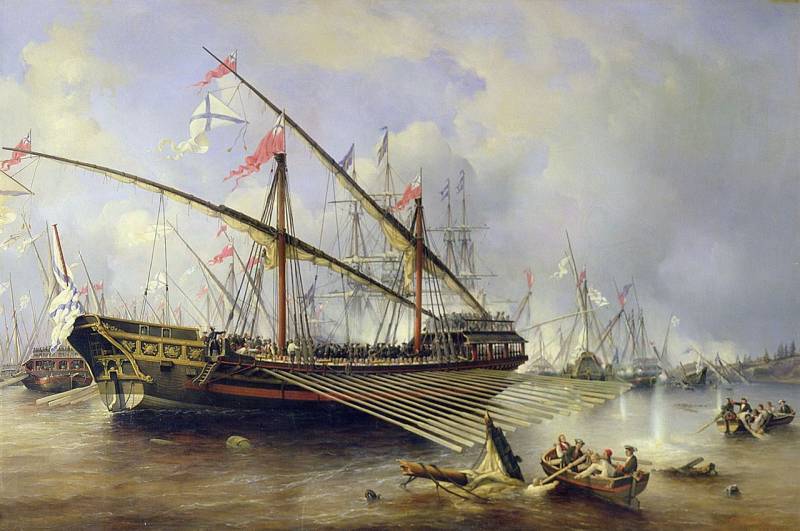
Battle of Grenham.
The Swedish Navy and the Great Northern War
By the end of 1700, the Swedish fleet consisted of 39 ships, divided into 4 ranks. These ships were 116–180 feet in length, had crews ranging from 210 to 850 men, and carried from 46 to 108 guns. In addition, there were 13 ships of rank 5-6, often called frigates, 82-124 feet in length, crewed from 46 to 190 people and 16-36 guns. Of the lighter ships, there were shnyavas, two bombardment galliots, 4 yachts, two galleys and more than 29 transports, two of the latter could, if desired, be converted into frigates.
The microscopic number of small ships is noteworthy, and this despite the fact that most of the Gulf of Finland and the coast of Finland are cut up by islands and skerries, where it is difficult to use large ships.
Why was this decision made? The answer is from budget savings. From small fleet it was decided to refuse, and small ships built in the 1660s–1680s were simply not built as they were decommissioned.
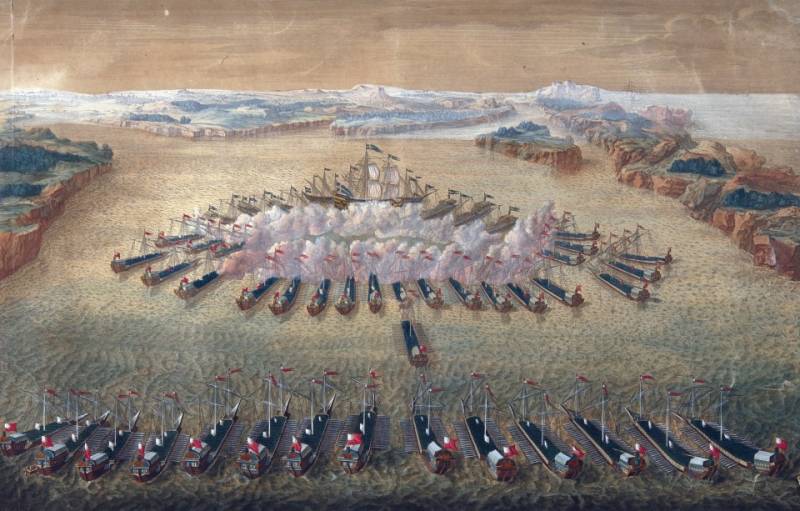
Battle of Gangut.
By 1700, the Admiralty had requested 113 riksdaler for the construction of 056 new ships, of which three were planned for Gothenburg (Western Squadron). In total, in 4, 1700 riksdalers were allocated to the Admiralty.
The main problem of the Swedish fleet was that a large number of its ships were very old. Of the 39 battleships in 1700, 15 were more than 20 years old, and another 8 were between 10 and 20 years old. Therefore, in 1701, the Admiralty requested an additional 22 riksdaler for the construction of one ship of the line, and several ships were declared unfit for service. In addition, it was urgent to build 500 more frigates, since the situation with frigates was exactly the same, they needed 4 riksdalers. Finally, another 32 riksdaler were required to manufacture the required number of bombardment ships for the fleet.
In 1702, 113 riksdaler were requested for the construction of ships. It was planned to lay down 482 battleships, 2 brigantines and complete the construction of the 4 bombardment galliots that began to be built last year. But the Swedish Treasury in 4 had only half of the requested amount. As a result, the construction of the galliots was suspended; instead of a new battleship, they decided to restore the Småland (its timbering cost a wild sum, three-quarters of the new one) and launched 1702 brigantines and 2 half-galley.
1703 For the construction of at least one new ship, the Admiralty requests 20 riksdaler, and in total for the construction of ships - 251 riksdaler. Receives 66 riksdaler, which allowed the laying of one 000-gun ship and a half-galley, as well as the completion of 55 frigate and 251 brigantines.
In 1704, 84 riksdalers were required to complete and launch a battleship and frigate. This amount was obtained through annexations and indemnities from Poland. Encouraged, the Admiralty next year requested 499 riksdaler for a 106-gun ship, two ships of 437 ranks and a 90-gun frigate. But the money ran out, and nothing was allocated for the construction of ships.
Nevertheless, in 1706, a 70- and 50-gun ship was launched, which cost 53 riksdaler. In fact, their construction should have cost much more - the estimate was 583 riksdaler. In total, the fleet received 125 riksdalers that year instead of the requested 997 riksdalers. To ensure this amount, 326 riksdaler were simply withdrawn from the maintenance of sailors and port infrastructure (barracks, baths, warehouses, workshops, etc.).
The same thing was done in 1707, and in 1708, and in 1709. As a result, 5 ships were built to complement the three that could be launched in 1706.
But this was not enough, because the fleet continued to materially age and wear out. In addition, the Treasury began to persistently reduce the allocation of funds for the maintenance of the fleet; in 1720, only 112 riksdaler were allocated for the fleet.
As a result, this is what the ship's composition looked like in tabular form.
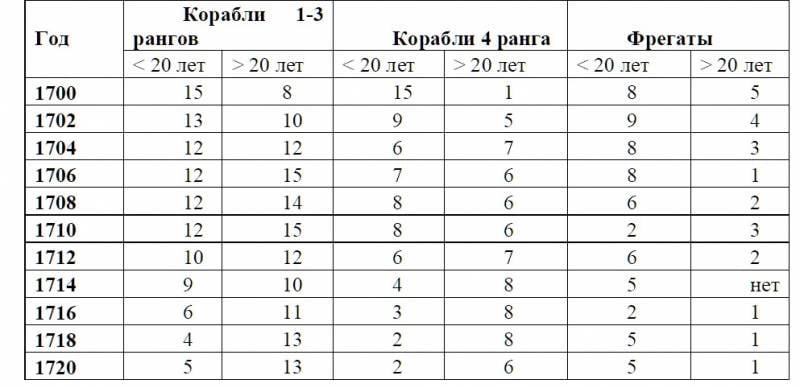
The result of this policy in the matter of ship construction and equipment is summed up by the list of ships inspected by Karl Sheldon.
Sverige - unusable for the last eight years - not worth repairing (repairs will cost 3/4 the cost of a new ship).
“Victoria” has not been able to go to sea due to rottenness for three years.
"Estland" and "Livland" - for scrapping.
“Wrangel” - during ten years of being in the port of Stockholm, it actually sank in shallow water “you can barely walk on the lower deck, 6 of the 8 beams simply collapsed into the hold.”
“Halland” is docked in the port of Stockholm, but if you give up the mooring lines, there is no certainty that it will not immediately sink.
Finally, the Konung Carl, the flagship of the fleet, is actually a skeleton, since all the sails and rigging on it simply rotted, the yards collapsed, and supplies from Riga are no longer expected.
Super Raiders before it became mainstream
The best example of the Admiralty's management of ship construction will probably be this story.
After Poltava, Karl fled to Turkish Bendery, where he stayed until 1715, but kept his finger on the pulse of affairs in Sweden and wrote long letters to the royal council about what and how to do.
The Turks (according to Swedish data) nicknamed it “mischievous lightning”, in fact it turns out to be an analogue of a ball lightning – yıldırım yaramaz, where the second word is translated as mischievous, harmful, naughty, inept. Apparently, Karl knew about this nickname. But how is it related to the fleet? That's how.
Next is the story of Gibert Sheldon.
So, the year is 1713, and Charles XII writes a letter to Charles Sheldon (Gilbert’s grandfather or great-grandfather), one of his main shipbuilders, and asks to build two one-deck frigates for the Swedish fleet, which he calls “Yıldırım” and “Yaramaz”, however, with a Swedish accent ("Jilderim" and "Jaramas").
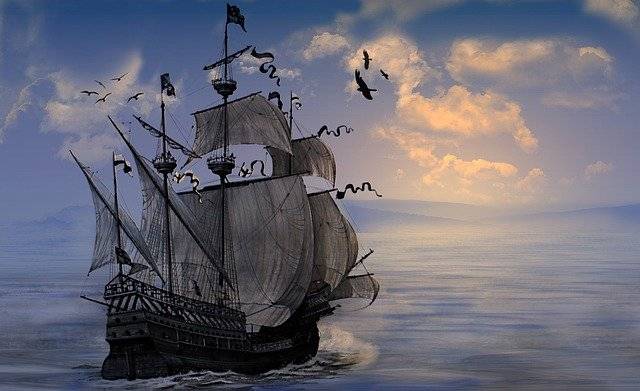
Approximate view of the frigate "Jilderim".
At first, His Majesty planned to make these ships 60-gun, but then he quickly realized that so many would not fit on one deck, and mercifully reduced the number of guns to 54. The guns had to be 18-pounders in the deck, and 8-pounders in the superstructure.
The Admiralty Board met and began to discuss the budget, but finances in Sweden were very bad, and it was decided to once again reduce the number of guns. Until thirty. But put in all the 18-pounders. It turned out to be a kind of super-frigate, ready to tear apart the enemy, but then the chief storekeeper of the fleet stepped in. He said bluntly - there are no cannons in the navy's warehouses. Or rather, there are exactly 30 of them, if we are talking about 18-pound ones. But there are 8- and 12-pounders in abundance. That is, with superfrigates everything is complicated. What do we do? We decided so. Let's distribute the guns between two frigates, but for good measure we'll add 4 more small guns to the ship. We'll get 34 guns.
And finally, the project took on its final form.
Jilderim carried twenty-four 18-pounder guns and ten 8-pounder guns.
Jaramas carried the remaining six 18-pounder guns, eighteen 12-pounders and ten 8-pounders. True, then all the 18-pounders were removed, and the final armament of the frigate became twenty 12-pounder guns and ten 8-pounder guns.
The life of the Jilderim was short - it was captured by two Danish 1717-gunners in 50, but the Jaramas served for a long time - until 1741, when it was scrapped.
Well, Gilbert Sheldon, who also worked as a shipbuilder in Sweden, had to build another “Jaramas” - a 34-gun ship with twenty-two 12-pounder and twelve 4-pounder guns. By the way, this ship survived right up to the Battle of Hogland in 1788 and took part in the battle with the Russian squadron, although in the role of an extra.
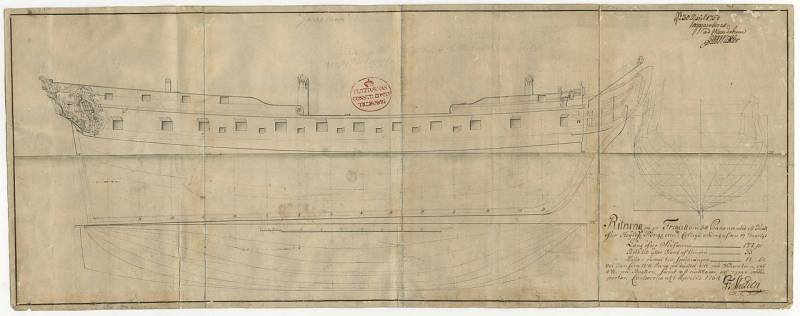
Technical drawing of the frigate "Jaramas" built in 1759.
The Turks believe that Charles XII was inspired by Algerian frigates, although if you take data on any Algerian, you can see that this is not so.
English researchers believe that Charles decided to create super raiders, destroyers of trade, anticipating American super frigates by 100 years. The problem is that this was an attempt to pass off need as virtue. Karl's project to create conventional 50-gunners simply shrunk to 34-gunners due to the fact that the Swedes had neither money nor spare parts and equipment, because the fleet in 1713–1716. supplied on a residual basis.
Archipelago fleet
By the end of the Northern War of 1700–1721. Russian galleys simply tormented the Swedish coast, and the Swedes drew their conclusions. A flotilla of galleys was created in Skeppsholmen (then a suburb of Stockholm), whose task was to operate in the shallow waters of Finland. It was called the Stockholm squadron (Stockholmseskadern). But in the war with Russia of 1741–1743, it turned out that the Swedes had too few galleys, because “size matters.” That is why, in 1747, the creation of the Army Fleet, or Archipelago Fleet, began.
The baptism of the Swedish Army Fleet was the landing of 1 troops on the island of Usedom for the siege of Peenemünde-schanz. After 100 days of fighting and shelling, Peenemünde fell. Well, in 10, the Swedish galley fleet destroyed the Prussian galleys at the Frisches Haff roadstead in Stettin. And in 1759, the galley fleet was removed from the subordination of the fleet and placed under the subordination of the army, or rather, the Kriegskollegium (analogous to the General Staff). Now it became known as the Army Fleet (Arméns flotta). At the same time, the Stockholm squadron of galleys, based in the capital, remained under the jurisdiction of the fleet, but rowing ships and vessels in Sveaborg, Abo, Turku, Gothenburg, and Pomerania now had the supremacy of the army.
Next, the galley fleet was divided into two squadrons - Swedish and Finnish, and finally, in 1777, it was finally given to the army. At the same time, sailors and officers on ships were recruited from among the sailors, but artillerymen and soldiers were recruited from the army.
And then the Swedish shipbuilding genius unfolded with all its might, because the Swedes wanted to gain not only a numerical, but also a technical advantage in a hypothetical battle in the Archipelago. Traditional galleys were effective as amphibious transport vessels for amphibious operations, but were weakly armed, especially when compared with a large crew: a galley with a crew of 250, almost all of whom were oarsmen, typically had only one 24-pounder gun and two 6 -pounders, all in the bow. And in 1760, the first type of rowing frigates, the Udem, was developed.
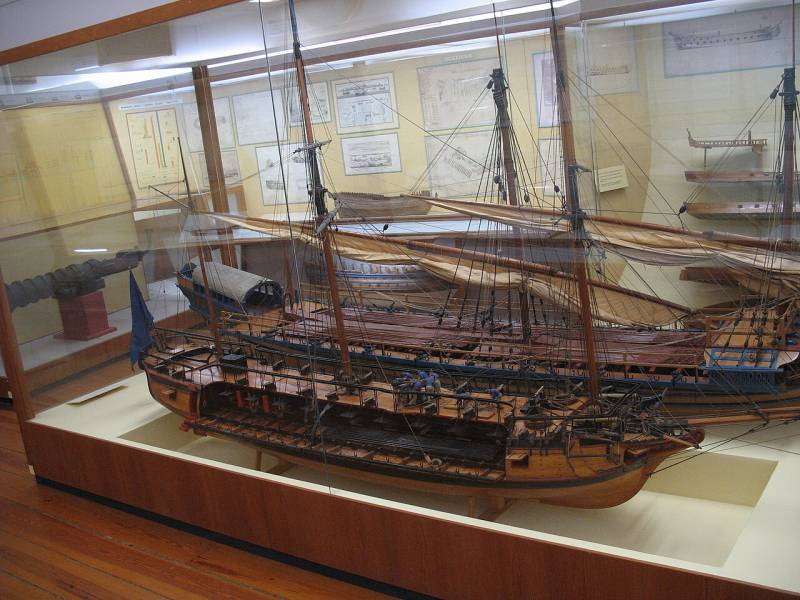
Udema Thorborg. Model in the Swedish Maritime Museum.
The idea was the following - to build a deck above the rowers, which would be used as an artillery deck. The first rowing udema frigate "Gamla" had eight 12-pounders on board and two 12-pounders in the bow, while the length of the ship was 30 meters and the draft was only one and a half meters. The sailing armament consisted exclusively of lateen sails.
But it is clear that the superstructure made the rowing frigate much slower than the galley; in battle, the rowers were constantly injured by chips and fragments of wooden structures from the cannonballs, and the gunpowder smoke that accumulated on the rowing deck did not allow them to row effectively.
Overall, Udem was soon recognized as a bad decision. Even new iterations in 1776, which used gun ports for rowing (that is, the ship could either fire or row), were slightly improved, but did not radically change the situation.
In 1764, another type of rowing frigate was developed - the pojama. In essence, it was a reinforced galley, with a pair of 12- or 24-pound guns at the bow and stern. The sailing rig consisted of two masts with lateen sails. In addition, provision was made for the cannons to be moved to a central elevated platform, which theoretically made it possible to fire along the side. But this process was so labor-intensive that it was never used.
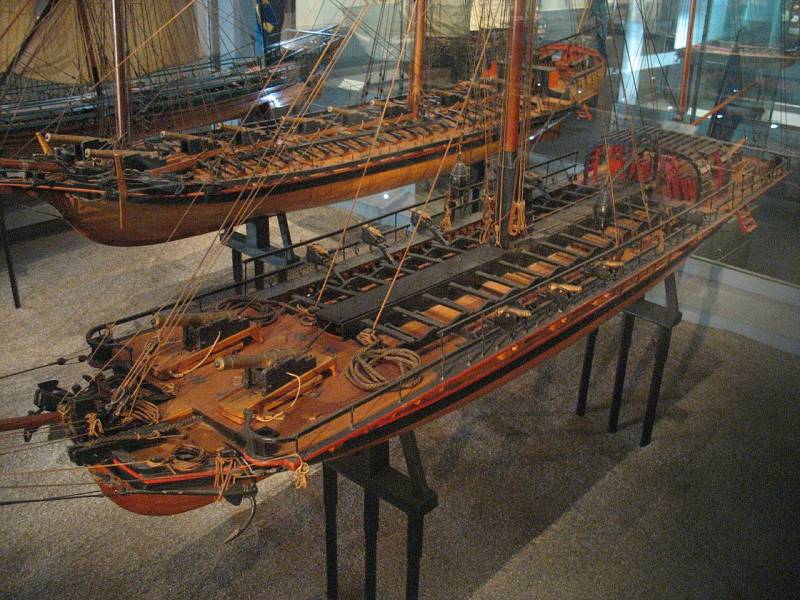
Brynhilda Pojama. Model in the Swedish Maritime Museum.
The Poyama had a length of 23,8 m, a width of 5,5 m and a draft of 1,8 m; there were only four ships of this type in the Swedish fleet, their scope of use was limited to reconnaissance and delivery of dispatches.
Compared to galleys, the new types of ships had better protection for the crew and three times the capacity. They could operate in skerries in any weather and on high water on all days except the most severe storms. They had a deeper draft than galleys, but significantly less than traditional sailing warships.
The next type of archipelago frigate was the Turuma. In essence, it was a strengthened, slightly modified udema. The hull was lengthened to 38,5 meters and widened to 9,5 meters, but otherwise had the same design. For additional mobility, the turuma had 19 pairs of oars (16 pairs on the first two ships), which were rowed by four people per oar. The rowers, unlike the udema, were located on the upper deck, above the gun deck. The oar pad (a device for securing the oar at the side) was located on outriggers, which gave a greater leverage effect.
Turums rowed slowly; in calm weather their speed was barely half a knot; it was generally impossible to row them against the wind. Let's compare it with an ordinary galley, which could reach speeds of up to 7 knots, and for a long time without fatigue of the rowers could sail at 3-4 knots.
Unlike the Udem, the Turums carried sailing rigs of the “ship” type (straight sails on the first two masts, slant sails on the mizzen). Turuma carried twenty-four 12-pounder cannons (ten on each side, two cannons in the bow and two in the stern), that is, it could easily give battle to even an ordinary 12-pounder frigate.
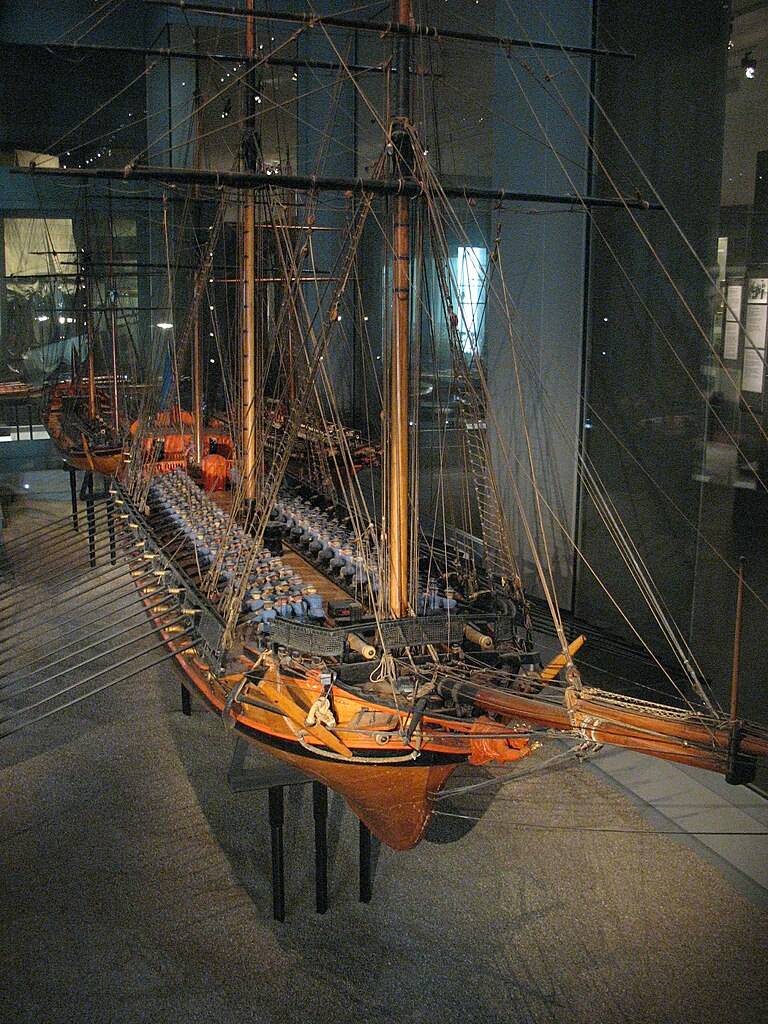
Turuma Lodbrok. Model in the Swedish Maritime Museum.
One of the turums, Amphion, was built as a yacht, with a schooner rig, and during the Russo-Swedish War of 1788–1790 she became the headquarters ship of King Gustav III. However - the irony of fate - it was the Amphion that showed such disgusting seaworthiness that because of this, during the battle of Vyborg, the king was almost captured, having managed in time to switch to another, faster ship.
By 1788, Sweden had 7 ships of this type in service.
And finally, the crown of creation of sailing-rowing frigates was considered to be the gemmema. In the construction of the frigate, the Swedes returned to the idea of udema - the rowers should be located on the lower deck, this will allow them to develop greater speed. Along with the increase in size (length was 44,5 meters, width - 11 meters, 20 pairs of oars, draft 3 meters), the armament was also strengthened. The gememmas carried twenty-two 36-pounder guns, plus two 12-pounder guns.
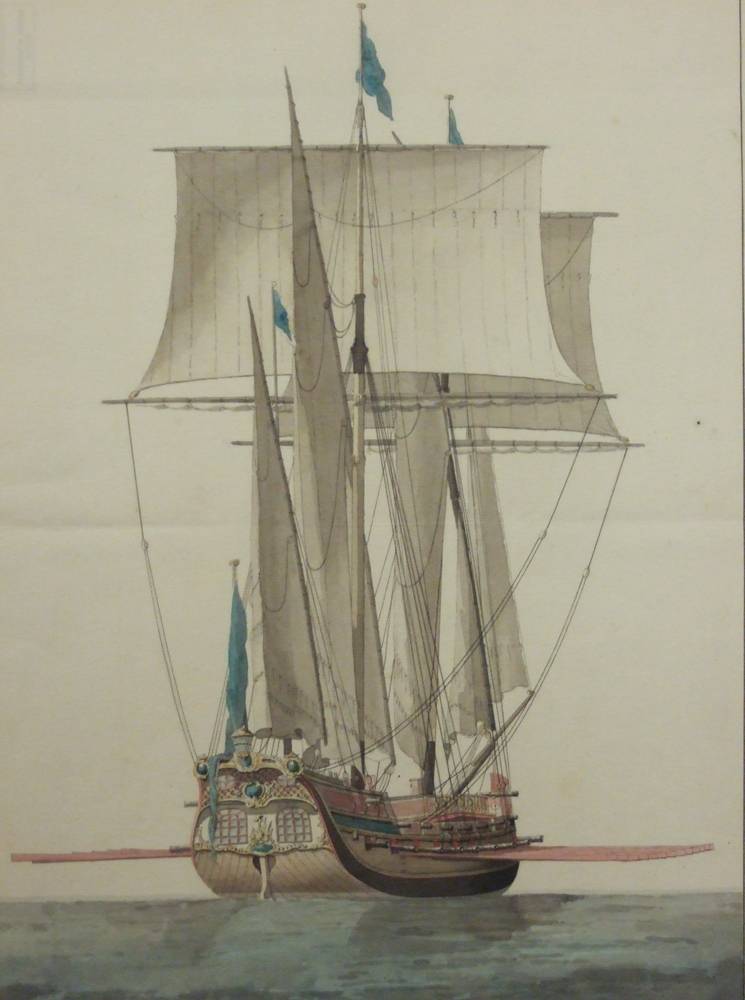
Gemma Oden.
In total, the Swedes had 9 such ships, which historian Jan Glete called “superfrigates of the Archipelago.”
Some conclusions
Did these ships help the Swedes in the wars with Russia in 1788–1790? and in 1808–1809?
Yes and no. In the war of 1788–1790. the Russians had to improvise, because Russia’s galley fleet was frankly small, and at the first stage the Russians focused on the usual galleys and gunboats, which were supported whenever possible by sailing frigates and sloops. However, already in 1789, the Russians began building rowing frigates of the Mediterranean type - half-acre and shebek.
Already in the first Battle of Rochensalm, 6 turums, 3 udems, 1 poyama and 1 gememma took part in the battle on the Swedish side, while on the Russian side - 8 half-acres and five sailing brigs. As a result of the ensuing battle, the Swedes lost 3 turums, a heme and a poyama, while Russian losses were limited to 1 galley and 1 gunboat.
In the second Battle of Rochensalm, rowing frigates, being pre-positioned in defensive positions, inflicted colossal losses on the Russians, and in Sweden this is extolled in every possible way as a key victory of that war.
However, in essence, the Army Fleet for Sweden became a fleet of one battle, or rather, one victory, because no one drew conclusions or worked on mistakes.
That is why in the war of 1808–1809. The Swedish Army Fleet, frankly speaking, did not shine, and a third of it generally fell into the hands of the Russians without a fight during the surrender of Sveaborg.
References:
1. Lars O. Berg “Karolinsk flotta. Studier och tabeller Av förste arkivarie” – “Forum navale”. 1970. No. 25.
2. Lars O. Berg “Skärgårdsflottans fartyg: Typer och utveckling under 1700 – och 1800-talet” – Historiska media, Lund. 2000.
3. Anderson, Roger Charles, “Oared Fighting Ships: From classical times to the coming of steam” – London. 1962.
4. Gunnar Artéus (redaktör) “Gustav III:s ryska krig” – Probus, Stockholm. 1992.
5. Harris, Daniel G, Fredrik “Henrik af Chapman: The First Naval Architect and his Work” – Literatim, Stockholm. 2001.
Information